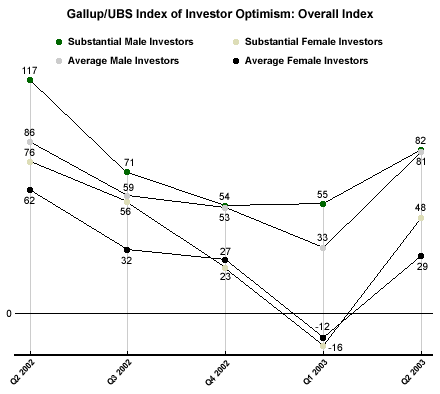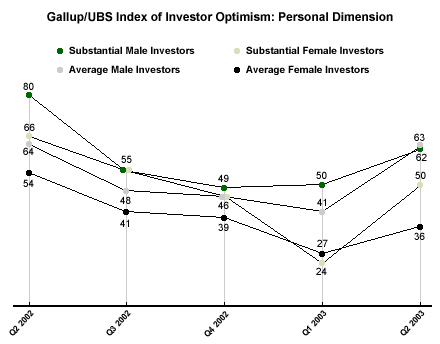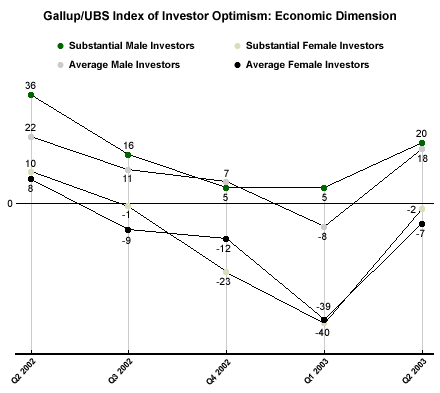Women just don't have a head for numbers, let alone for making important financial decisions. They tend to worry more the ups and downs of their weight than the ups and downs of the stock market. Women in financial circles, and smart investment advisers, have been fighting these ridiculous -- and often harmful -- stereotypes for decades.
In fact, in some ways women are better investors than men are: women tend to do more research, are less likely to act on "hot" tips, ask more questions, and don't move money around as much, said Brenda Buttner, a FoxNews financial journalist, in a Mutual Funds Investor's Center column. The bottom line -- literally -- is this: women tend to be slightly better investors than men, according to a University of California at Davis study. However, male investors tend trade more often than women do and take more risks, which is perhaps why the current investment climate may seem slightly more appealing. The last five quarters of Gallup/UBS Index of Investor Optimism data* show that men are much more optimistic than women about the investment climate-- and presumably more likely to buy stocks despite the uncertain economy.
The Index includes the opinions of people with $10,000 to $99,999 in investable assets -- "average" investors -- and "substantial" investors with at least $100,000 in investable assets. The gender difference transcends those categories: There is not one instance in the last five quarters in which substantial female investors had as much overall optimism as substantial male investors or average male investors.
In the second quarter of 2002, substantial male investors' overall optimism was at 117 on the Index. Average male investors were at 86. Substantial female investors came in at 76, and average female investors were at 62.
In the first quarter of 2003, it had become clear that the economy had not improved, and investor optimism plummeted. Yet the gender gaps persisted and actually grew. Substantial male investors were at 55, average male investors were at 33, substantial female investors were at -16, and average female investors were at -12.
Even in the last quarter, when it looked like the markets were perking up, substantial female investors (48) were significantly less optimistic than both substantial male investors (82) and average male investors (81).

Personal Dimension
The Personal Dimension of the Index is especially significant because it asks people to consider their own finances. Respondents' optimism tends to show up most clearly among this set of questions. Intriguingly, this is the dimension along which optimism of female investors tracks the most closely with that of male investors.
In the second quarter of 2002, substantial male investors led the pack as usual, with a score of 80 on the Personal Dimension of the Index. Substantial female investors were at 66, edging out average male investors at 64, and average female investors were at 54. In the third quarter of 2002, substantial female investors and substantial male investors were even at 55, average male investors were at 48, and average female investors were at 41. By the last quarter of 2002, substantial male investors were at 49, substantial female investors and average male investors were even at 46, and average female investors brought up the rear at 39.
But during the first two quarters of 2003, optimism among male investors (both substantial and average) pulled far ahead of that for both substantial female and average female investors.

Economic Dimension
Index data shows that all female investors have been rather pessimistic, but optimism on the Index's Economic Dimension -- which measures optimism about the economy as a whole -- has been dripping, sometimes flooding, away for both sexes since 2002. Of all four groups of investors, only substantial male investors have kept their economic optimism in positive territory during the last five quarters: at 36 in the second quarter of 2002, 16 in the third quarter of 2002, 5 in both the fourth quarter of 2002 and the first quarter of 2003, and back up to 20 this past quarter. Average male investor optimism followed a similar track as substantial male investor optimism, although it dropped briefly below zero at -8 in the first quarter of 2003.
On the other hand, optimism among average female investors was on the plus side only once, when it was at 8 in the second quarter of 2002. It dropped dramatically from there, reaching a dismal -39 in the first quarter of 2003, and then moved back up to -7 in the second quarter. Substantial female investor optimism rose and fell similarly to average female investor optimism, and is now close to positive territory at -2.

Bottom Line
Investment advisers such as Charles Schwab have been reaching out to women investors in recent years. It's a good move -- though they still earn less than men do, more women are joining the ranks of serious investors. Women also tend to outlive their husbands -- the average age of widowhood is 56, and 90% of women are going to be solely responsible for their own finances at some point, according to an ongoing OppenheimerFunds study.
*Results are based on telephone interviews with more than 1,000 investors nationwide, aged 18 and older, conducted monthly since January 2000. For results based on these total samples, one can say with 95% confidence that the margin of sampling error is ±3 percentage points.

